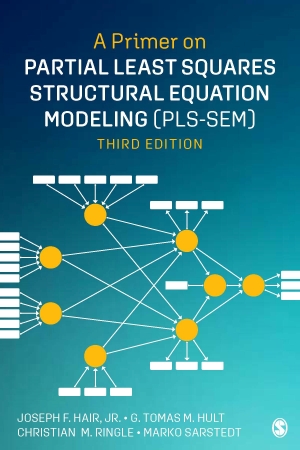The PLS-SEM Book
Hair, J. F., Hult, G. T. M., Ringle, C. M., & Sarstedt, M. (2022). A Primer on Partial Least Squares Structural Equation Modeling (PLS-SEM), 3rd ed. Thousand Oaks, CA: Sage.
All case studies in this PLS-SEM book use the SmartPLS software.
Brief Description
With applications using SmartPLS — the primary software used in partial least squares structural equation modeling (PLS-SEM) — this practical guide provides concise instructions on how to use this evolving statistical technique to conduct research and obtain solutions. Featuring the latest research, new examples, and expanded discussions throughout, the third edition is designed to be easily understood by those with limited statistical and mathematical training who want to pursue research opportunities in new ways.
Free download of the updated primer book (3e) case studies using SmartPLS 4
The third edition of "A Primer on Partial Least Squares Structural Equation Modeling (PLS-SEM)" used SmartPLS 3 for the case studie. Here, you can download a free update of these case studies using SmartPLS 4:
- Chapter 2 - Specifying the Path Model and Examining Data
- Chapter 3 - Path Model Estimation
- Chapter 4 - Evaluation of Reflective Measurement Models
- Chapter 5 - Evaluation of Formative Measurement Models
- Chapter 6 - Evaluation of the Structural Model
- Chapter 7 - Mediation and Moderation Analysis
New to this edition
- All screenshots and instructions have been updated for the latest edition of the SmartPLS 3 software.
- The latest research on the nature of composite-based modeling provides a more thorough conceptual foundation for PLS-SEM.
- More on the distinction between PLS-SEM and CB-SEM helps readers choose the right technique for their project.
- Applications of PLS-SEM with secondary or archival data shows readers even more applications for this approach.
- Improved guidelines for generating and validating single-item measures for redundancy analyses and determining minimum sample sizes help clarify these steps.
- Coverage of model fit, analysis of predictive power, and metrics of model comparison have all been expanded for a richer discussion of PLS-SEM.
- A thoroughly revised and updated Chapter 7 on mediator and moderator analysis covers more types of mediation, and provides updated explanations and guidelines on moderated mediation.
- Extended coverage of more advanced concepts helps readers go further with PLS-SEM
- Summaries are now structured by learning outcome for improved organization.
Short video
Key features
- Simple instructions give readers the “how-tos” of using the SmartPLS software to obtain solutions, and prepare manuscripts using PLS-SEM for academic journal submissions.
- Rules of thumb in every chapter provide guidelines on best practices in the application and interpretation of PLS-SEM.
- A focus on accessibility is reflected through limited equations, formulas, and Greek symbols to facilitate clear understanding.
- Chapters organized around learning outcomes simplify the process of learning the concepts and statistical terms.
- Concepts consistently defined in plain language further facilitate comprehension of methods.
Brief table of contents
- Chapter 1: An Introduction to Structural Equation Modeling
- Chapter 2: Specifying the Path Model and Examining Data
- Chapter 3: Path Model Estimation
- Chapter 4: Assessing PLS-SEM Results — Part I: Evaluation of Reflective Measurement Models
- Chapter 5: Assessing PLS-SEM Results — Part II: Evaluation of the Formative Measurement Models
- Chapter 6: Assessing PLS-SEM Results — Part III: Evaluation of the Structural Model
- Chapter 7: Mediator and Moderator Analysis
- Chapter 8: Outlook on Advanced Methods
- Glossary
The authors
Joseph F. Hair, Jr. is Cleverdon Chair of Business, and director of the PhD degree in business administration, Mitchell College of Business, University of South Alabama. He previously held the Copeland Endowed Chair of Entrepreneurship and was director of the Entrepreneurship Institute, Ourso College of Business Administration, Louisiana State University. Joe was recognized by Clarivate Analytics in 2018, 2019, and 2020 for being in the top 1% globally of all business and economics professors based on his citations and scholarly accomplishments, which exceed 238,000 over his career. He has authored more than 75 books, including Multivariate Data Analysis (8th edition, 2019; cited 140,000+ times), MKTG (13th edition, 2020), Essentials of Business Research Methods (2020), and Essentials of Marketing Research (4th edition, 2020). He also has published numerous articles in scholarly journals and was recognized as the Academy of Marketing Science Marketing Educator of the Year. As a popular guest speaker, Professor Hair often presents seminars on research techniques, multivariate data analysis, and marketing issues for organizations in Europe, Australia, China, India, and South America. He has a new book on Marketing Analytics (McGraw-Hill).
G. Tomas M. Hult is professor and Byington Endowed Chair at Michigan State University (USA), and holds a visiting chaired professorship at Leeds University Business School (United Kingdom) and a visiting professorship at Uppsala University (Sweden). Professor Hult is a member of the Expert Networks of the World Economic Forum and United Nations/UNCTAD’s World Investment Forum and is also part of the Expert Team at the American Customer Satisfaction Index (ACSI). Dr. Hult was recognized in 2016 as the Academy of Marketing Science/CUTCOVector Distinguished Marketing Educator; he is an elected fellow of the Academy of International Business; and he ranks in the top 10 scholars in marketing per the prestigious World Ranking of Scientists. At Michigan State University, Dr. Hult was recognized with the Beal Outstanding Faculty Award in 2019 (MSU’s highest award “for outstanding total service to the University”), and he has also been recognized with the John Dunning AIB Service Award for outstanding service to AIB as the longest-serving executive director in AIB’s history (2004–2019) (the most prestigious service award given by the Academy of International Business). Professor Hult regularly teaches doctoral seminars on multivariate statistics, structural equation modeling, and hierarchical linear modeling worldwide. He is a dual citizen of Sweden and the United States. More information about Professor Hult can be found at http://www.tomashult.com.
Christian M. Ringle is a chaired professor of management at the Hamburg University of Technology (Germany) and an adjunct professor at the University of Waikato (New Zealand). His research addresses management of organizations, human resource management, and methods development for business analytics and their application to business research. His contributions in these fields have been published in journals such as International Journal of Research in Marketing, Information Systems Research, Journal of the Academy of Marketing Science, MIS Quarterly, Organizational Research Methods, and The International Journal of Human Resource Management. Since 2018, he has been named member of Clarivate Analytics’ Highly Cited Researchers List. In 2014, Professor Ringle co-founded SmartPLS, a software tool with a graphical user interface for the application of the partial least squares structural equation modeling (PLS-SEM) method. Besides supporting consultancies and international corporations, he regularly teaches doctoral seminars on business analytics and multivariate statistics, the PLS-SEM method, and the use of SmartPLS worldwide. More information about Professor Christian M. Ringle can be found at https://www.tuhh.de/hrmo/team/prof-dr-c-m-ringle.html.
Marko Sarstedt is a chaired professor of marketing at the Ludwig-Maximilians-University Munich (Germany) and an adjunct professor at Babeș-Bolyai University, Cluj (Romania). His main research interest is the advancement of research methods to enhance the understanding of consumer behavior. His research has been published in Nature Human Behavior, Journal of Marketing Research, Journal of the Academy of Marketing Science, Multivariate Behavioral Research, Organizational Research Methods, MIS Quarterly, and Psychometrika, among others. His research ranks among the most frequently cited in the social sciences. Professor Sarstedt has won numerous best paper and citation awards, including five Emerald Citations of Excellence awards and two AMS William R. Darden Awards. According to the 2020 F.A.Z. ranking, he is among the most influential researcher in Germany, Austria, and Switzerland. Professor Sarstedt has been named member of Clarivate Analytics’ Highly Cited Researchers List, which includes the “world’s most impactful scientific researchers.”
Comments
Claes Fornell, Chairman, CFI Group Worldwide: “Partial least squares’ modeling is a very robust and practical technique to tackle many of today’s multi-equation econometric models. In many situations, researchers are interested in both prediction and causality. Since PLS aims to account for the trace (sum of the diagonal in the covariance matrix), it is well suited for prediction. This is in contrast to covariance structure models, where the objective is to account for all the observed variable covariances, which is not particularly relevant for prediction. For the American Customer Satisfaction Index, we have used our own version of PLS since the very beginning. This book, by a great author team, puts PLS more practically into the hands of researchers by creating a logical and understandable way of applying PLS-based predictions based on structural relationships. The result is that we will likely see more use of PLS in research, and significant advances to complex data problems.”
Yves Doz, Solvay Chaired Professor of Technological Innovation, INSEAD: “Partial least squares’ modeling is an important statistical technique in management research but one that is most often used by very statistically oriented academicians. The PLS book written by a great team of authors who are all very familiar with using PLS makes the technique more practically understandable. Given the type of data used in management research, this book will facilitate the confident use of PLS by a much larger number of researchers to test holistic multi-equation models.”
David Ketchen, Lowder Eminent Scholar, Auburn University: “This PLS book is concise and application-oriented while being scientifically rigorous. With the use of PLS becoming more widespread and important as a tool in the field of management, this PLS book, by a superb author team, gives more scholars the needed practical knowledge to conduct rigorous research on partial least squares modeling.”
Roger Calantone, Eli Broad Chaired University Professor of Business, Michigan State University: “Partial least squares’ modeling is a great solution technique for a variety of small and large multivariate data problems. This book provides a deeply informed, yet practical, guide to understanding and using PLS for both novice and advanced researchers. This approach to understanding PLS carries one from a preliminary overview of the technique and its application, through the many subtle, but powerful nuances of the method. After 27 years of teaching variations of SEM, I am happy to discover a book that provides a gateway for the novice and a roadmap for the expert to confidently and appropriately model and estimate with PLS in a broad range of research contexts.”
Reviews
Ketchen Jr, D. J. 2013. "A Primer on Partial Least Squares Structural Equation Modeling." Long Range Planning 46 (1–2): 184-185.
Read more, it's open access!


